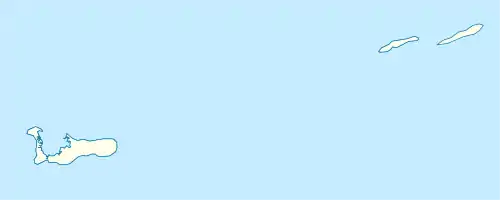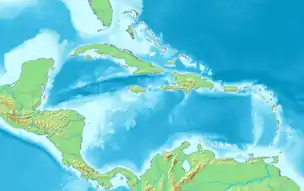Little Cayman
Little Cayman is one of three Islands comprising the Cayman Islands. It is located in the Caribbean Sea, approximately 60 miles northeast of Grand Cayman and five miles (8 km) west of Cayman Brac. Little Cayman is by far the least populous, with a permanent population of about 250. The majority of the population are ex-pat workers from Jamaica, Philippines & Honduras and from other Latin American countries as well as Canada, USA, India, South Africa, and England. There are a handful of local Caymanians estimated as less than 20. It is about 10 miles (16 km) long with an average width of 1 mile (2 km) and most of the island is undeveloped. Almost the entire island is at sea level. The highest elevation is about 40 feet (12 metres).
 Little Cayman from space, 3 March 2007 | |
 Little Cayman  Little Cayman | |
| Geography | |
|---|---|
| Location | Caribbean |
| Coordinates | 19°41′N 80°03′W |
| Archipelago | Greater Antilles |
| Administration | |
| Territory | |
| Largest settlement | George Town |
| Demographics | |
| Population | 270 (2018) |
| Ethnic groups | 60.2% Black
15.3% White 15.2% Multiracial 6.5% Asian |
Despite its small size, the island hosts a heritage festival and parade as part of Pirates Week, (Nov.) and the annual LC Agriculture Show (May) which also occurs on all three Islands, but at different dates in that same month.[1]


History
The first recorded sighting of Little Cayman, along with Cayman Brac, was by Christopher Columbus on May 10, 1503, on his fourth and final voyage, when heavy winds forced his ship off course.
The first settlement on the Island was in the 17th century when turtle fishermen set up camps that would supply pirate & military ship convoys with fresh meat (turtles, penned pigs, goats, poultry) and freshwater. There are freshwater springs that run underground in cavernous veins. After a raid by a Spanish privateer, these settlements were abandoned in 1671. The island was not resettled until 1833, when the second recorded settlement of Blossom Village was established by a few families, mostly with the surname Bawden or Bodden, Scotts, and Ritch, who are said to have been part of Cromwell's army in Jamaica. By the early 20th century, a few hundred people lived on Little Cayman and exported phosphate ore, coconuts, and marine rope. There were also schooners being built. While the first settlement and harbor were on the northside coastline in the area off of the "Bloody Bay Wall", Blossom Village" on the southside, on South Hole Sound, and is where the school, stores, Post office, park, and the back sandy road are located today.
Attractions
Diving
Little Cayman is famous for its scuba diving. The most popular dive site areas, Bloody Bay and Jackson's Bight, are both located on the north side of the island, just west of its midpoint. The deeper sites on its south side are generally visited on winter days when the north side is too rough. Little Cayman features dive sites as shallow as 20 feet and its walls are deep enough to be effectively infinite.[2]
Bloody Bay, in particular, is consistently ranked as one of the world's top dive sites. Many dive operations claim the late Philippe Cousteau declared its wall to be one of the three best dives in the world, although this story may be apocryphal. At its shallowest point, the drop-off begins at a depth of 18 feet, allowing divers who plan carefully to achieve maximum depth of over 100 feet but still enjoy exceptionally long dive times. But the wall is so famous primarily because sections of it are so sheer as to be effectively vertical, a rarity.
The most vertical section of the wall (the dive site "Great Wall West") was immortalized in 1999 by the Bloody Bay Wall Mural Project.[3] A crew of photographers directed by Jim Hellemn photographed the wall piece by piece and the images were compiled into a single, highly detailed image of the entire wall. The photograph was reproduced in National Geographic magazine in 2001. In 2010, photographers returned to the same section of wall in an effort to create a comparison image showing changes over the intervening decade.[4]
The depth of Little Cayman's dropoffs is often exaggerated by local divemasters claiming depths of 3,000 feet (910 m) or 5,000 feet (1,500 m). In truth, the 1000 m contour (3000+ ft) has been charted to be approximately one mile offshore on Little Cayman's Southside, and 2.5 miles (4.0 km) offshore of Bloody Bay on the island's Northside (Ibid), distances far beyond the areas dived by recreational divers.
Little Cayman's reefs are exceptionally healthy for a regularly dived area and inhabited by a full range of typical Caribbean reef life, from seahorses to sharks, and including a notable population of green sea turtles, Southern & Eagle rays.
In 2010, local dive operators launched a concerted effort to eradicate the invasive, non-indigenous red lionfish (Pterois volitans), which appears to be limiting its population around Little Cayman. On Wednesday afternoons, divemasters from the various resorts on Little Cayman embark on lionfish to hunt and cull the species. Since the hunts began, more grey Caribbean reef sharks (Carcharhinus perezii) are noticeable on dives. The lionfish are then sent to CCMI for research and after will be given out to restaurants to offer as a daily special.
Booby Pond and Rookery
Little Cayman's Booby Pond Nature Reserve supports the largest red-footed booby population in the Caribbean and is a designated Ramsar wetland of international importance. The site encompasses 82 hectares (200 acres). The Cayman Islands National Trust building on one edge of the pond offers to view decks with telescopes, and the building itself is open for a couple of hours on weekday afternoons. It contains exhibits about Little Cayman's flora and fauna as well as souvenirs. There is NO entrance fee and donations are gladly accepted.
Rock Iguanas and other fauna
Little Cayman has the only substantial population (estimated at 2,000) of the critically endangered Lesser Caymans iguana. Predation by feral cats encroachment by humans into their habitat and road deaths have reduced their population on Cayman Brac to less than 100. The rock iguanas are easy to spot on Little Cayman and the National Trust unveiled a boardwalk in December 2013 that allows visitors to view one of their nesting areas. There are no Blue Iguanas found on Little Cayman only in East areas on Grand Cayman. There are Iguana warning slow down signs to be cautious in certain areas where they like to sun out on the road. The speed limit on Little Cayman is 25mph and being British dependant colony we drive on the left.
Little Cayman also hosts the critically endangered hawksbill sea turtle, and the threatened West Indian whistling duck (Dendrocygna arborea), also known as the black-billed whistling duck. The Tarpon Lake, a salt pond near the center of the island, boasts an unusual population of landlocked tarpon, a large silver fish that usually lives only in the ocean.
Owen Island
Owen's Island is a small islet off the south-western coast of Little Cayman. The only way to reach it on some windy days is by boat, or there is a water-taxi if you are not physically inclined or have young kids. The use of a kayak or standup paddleboard to cross South Hole Sound Lagoon can be rented. The islet features no buildings, homes, or human habitation, making it popular for honeymooners and adventurers. It has a white shallow sand bar which is suitable for kids, swimming, and snorkeling. Owen's Island is privately owned and they allow the use so please respect the cleanliness when visited.[5][1]
Point of Sand
Little Cayman has many rocky beaches suitable for walking or entry points for diving and snorkeling. But the island has only one truly fine swimming beach with an expanse of sand, a clean, sandy bottom, and a protective reef line: Point of Sand. Currents are often very strong, but the shallowest areas are suitable for careful wading even by nonswimmers. Point of Sand is located on the northeastern tip of Little Cayman and boasts a clear view of Cayman Brac five miles away. Indeed, the beach is sufficiently lovely that it attracts visitors from Cayman Brac who come over on boats. Sundays, in particular, find many local families using the beach, which is likely to be deserted on weekdays. The beach has a shelter with picnic tables and a barbecue, but no services of any kind and no water. Getting there requires a rented car or scooter; the determined and physically fit can get there on a bicycle.
Little Cayman Vacation & Rentals
When visiting the Little Cayman area, LCV can provide you with extensive Little Cayman information, Flats fishing, Bottom fishing, Bonefishing, Deep Sea Fishing, Snorkeling, Owens Island Water Taxi, Land tours & Eco sea tours, Daily apartment rental, Car & 7 seater van rental, Scooter rentals, as well as online grocery delivery, Local & Caribbean cooked food and even a Private chef for all snacks & daily meals.
Little Cayman Museum
A small collection focusing on local history is open for a few hours, usually weekday afternoons. There is no admission fee so donations after are appreciated and there is Tanya who has extensive knowledge of Rock Iguanas and she will happily educate and show you some of there burrows located behind the old museum.
Little Cayman Research Centre
This 6,600 square foot research center is located on the north side of Little Cayman and is a part of Central Caribbean Marine Institute (CCMI). CCMI is a not-for-profit organization founded in 1998 to protect the future of coral reefs through research, conservation and education.[6] Contact the staff there to schedule a very informative tour of the facility.
Accessibility and Services
Little Cayman is accessible by air (via Cayman Airways) via daily inter-island flights[7] from both Cayman Brac and Grand Cayman. Its only airport, Edward Bodden Airfield is on the southwest tip of the island. Little Cayman is not an entry point to the country; visitors and residents must land first on Grand Cayman(Owen Roberts International Airport) or Cayman Brac (Charles Kirkconnell International Airport) which are international airports.
Little Cayman has one grocery-and-hardware store, one online grocery store, one liquor store, one bank, three full-service restaurants and one local food delivery service, two churches, and two-car rental operations. There are four small souvenir/resort wear shops. It is served by the Edward Bodden Airfield, a two-man police force, a five-man fire crew with one truck and rescue boat, a full-time postmaster, a power station operated by Cayman Brac Power and Light, a clinic staffed by a nurse, and a one-room school whose enrollment is usually in single digits. Cellular phone service offered by LIME and Digicel has almost completely eliminated reliance on landlines, which many residents maintain primarily to allow them to connect to the Internet, which can only be accessed by ADSL. There are certain areas on the North East side that get no reception.
Little Cayman Education Services is the sole educational provider on the island.[8]
References
- "Little Cayman". Retrieved 17 March 2016.
- "Like Poseidon Himself Would Do". Retrieved 17 March 2016.
- "Bloody Bay Wall Project". Retrieved 17 March 2016.
- Portrait of a Coral Reef Project
- island.aspx "Owen Island" Check
|url=value (help). Retrieved 17 March 2016. - "CCMI". Retrieved 17 March 2016.
- "Getting Here - Caribbean Getaway, Cayman Islands Flights - Cayman Islands". Retrieved 17 March 2016.
- "Little Cayman Education Services." Cayman Islands Department of Education. Retrieved on September 14, 2016.
External links
 Little Cayman travel guide from Wikivoyage
Little Cayman travel guide from Wikivoyage- Little Cayman, Cayman Islands Tourism Official
- CIA World Factbook entry on Grand Cayman (updated May 2, 2006)
- Cayman Islands Government website of Cayman Islands Government